Cambodia
Population: 13,881,000
Capital: Phnom Penh
Time Zone: GMT +7
Part of 2006 World Trip, arriving from Thailand and going on to Malaysia.
A week exploring the truly spectacular Temples of Angkor.
Use the navigation bar on the left or the map-links to select a place. Alternatively scroll down to see all the entries. Click on photos to enlarge. See all Cambodia photos here.
Siem Reap
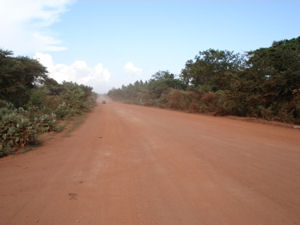 The bus trip from Bangkok to Siem Reap was something of a performance. Over two thirds of the journey was on the Thai side, where the roads were good, and, having set off early, we arrived at the border before lunch. Things slowed down somewhat after this. The actual border was the easiest I had encountered, but roads in this part of Cambodia are of quite a low quality. The photo shows a good bit of the only road, which was a mixture of sand and gravel. Hence, we slowly bounced along all afternoon, stopping for a couple of hours to fix the bus when an oil pipe broke. While Cambodia, like Laos, is a country dominated by rivers, in the north there are large expanses of farmland which can only support a single crop per year. This had just been harvested so the land looked barren for as far as the eye could see. However, as the sun set, there was the most spectacular lightning storm over the dusty planes, which seemed to continue well into the night and was very beautiful to watch. We, hence, finally arrived in Siem Reap about 10 pm in the evening.
The bus trip from Bangkok to Siem Reap was something of a performance. Over two thirds of the journey was on the Thai side, where the roads were good, and, having set off early, we arrived at the border before lunch. Things slowed down somewhat after this. The actual border was the easiest I had encountered, but roads in this part of Cambodia are of quite a low quality. The photo shows a good bit of the only road, which was a mixture of sand and gravel. Hence, we slowly bounced along all afternoon, stopping for a couple of hours to fix the bus when an oil pipe broke. While Cambodia, like Laos, is a country dominated by rivers, in the north there are large expanses of farmland which can only support a single crop per year. This had just been harvested so the land looked barren for as far as the eye could see. However, as the sun set, there was the most spectacular lightning storm over the dusty planes, which seemed to continue well into the night and was very beautiful to watch. We, hence, finally arrived in Siem Reap about 10 pm in the evening.
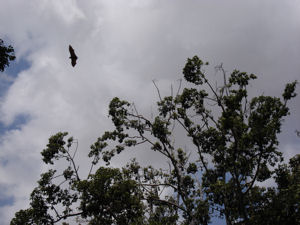 The town of Siem Reap is quite strange in many ways. Twenty or so years ago it must have been much like any other small town in Cambodia, but the growing popularity of Angkor Wat has changed all that. Enormous 5-star hotels, far bigger than any hotels I have ever seen before, line the main road as you enter the town and these roads, thanks to the Japanese, are of a very good quality. The old town is also packed with hotels, and this has led to serious competition. There was a guy on our bus persuading everyone to stay at his hotel, he asked me how much I was aiming to pay of a night and when I said $3 max and I planned to walk the few kilometres to a lonely plant recommended dormitory but he said he would see what he could do. When I arrived, I was given a triple room with bathroom to myself - $3 a night is better than nothing when there are thousands of empty beds, but the guys running the place continuously tried to sell me other stuff to get a little more money.
The town of Siem Reap is quite strange in many ways. Twenty or so years ago it must have been much like any other small town in Cambodia, but the growing popularity of Angkor Wat has changed all that. Enormous 5-star hotels, far bigger than any hotels I have ever seen before, line the main road as you enter the town and these roads, thanks to the Japanese, are of a very good quality. The old town is also packed with hotels, and this has led to serious competition. There was a guy on our bus persuading everyone to stay at his hotel, he asked me how much I was aiming to pay of a night and when I said $3 max and I planned to walk the few kilometres to a lonely plant recommended dormitory but he said he would see what he could do. When I arrived, I was given a triple room with bathroom to myself - $3 a night is better than nothing when there are thousands of empty beds, but the guys running the place continuously tried to sell me other stuff to get a little more money.
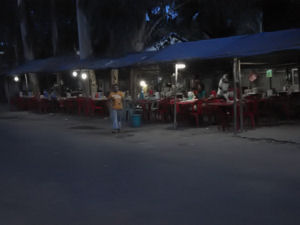 To see the Temples of Angkor you have to buy a pass, only valid of 1, 3 or 5 days. I purchased the 3 day pass so the next 3 days were spent rushing around trying to get my monies worth - see below - however, in the evenings, and on my last day, I had a little time to explore the town. Each night I went to the same little food stall near the old town - as ever this was far cheaper than any cafe or restaurant (I had put myself on a strict budget to have plenty of money for my last month travelling) and the guy running the place served really good fried rice with plenty of chillies. His wife also made the widest selection of fruit shakes I have ever seen, and I tried many interesting fruits I have never seen before or since. I also got to meet a few local students, and so was able to learn a little of the area first hand. I am sure if I had allowed myself a larger budget, I would have ended up eating somewhere that looked more appealing, but I loved this food stall a great deal and can really recommend the street food almost anywhere.
On my final day I wandered the markets and streets. There was a curious mixture of tourist outlets and local shops. Much of the centre is tourist orientated but the markets feel more aimed at the local needs and so there feels like 2 separate commercial worlds. This extends to almost everything, with roads being of a great quality near the hotels but quickly dropping back to gravel as you turn off. In the central park found a curious tree full of bats. I came back at sunset to see then fly off but they seemed happy to stay in the tree full time. The park, whilst small was quite nice and I watched an interesting game being played by some young Cambodians which had a shuttlecock which they were passing around using their feet.
To see the Temples of Angkor you have to buy a pass, only valid of 1, 3 or 5 days. I purchased the 3 day pass so the next 3 days were spent rushing around trying to get my monies worth - see below - however, in the evenings, and on my last day, I had a little time to explore the town. Each night I went to the same little food stall near the old town - as ever this was far cheaper than any cafe or restaurant (I had put myself on a strict budget to have plenty of money for my last month travelling) and the guy running the place served really good fried rice with plenty of chillies. His wife also made the widest selection of fruit shakes I have ever seen, and I tried many interesting fruits I have never seen before or since. I also got to meet a few local students, and so was able to learn a little of the area first hand. I am sure if I had allowed myself a larger budget, I would have ended up eating somewhere that looked more appealing, but I loved this food stall a great deal and can really recommend the street food almost anywhere.
On my final day I wandered the markets and streets. There was a curious mixture of tourist outlets and local shops. Much of the centre is tourist orientated but the markets feel more aimed at the local needs and so there feels like 2 separate commercial worlds. This extends to almost everything, with roads being of a great quality near the hotels but quickly dropping back to gravel as you turn off. In the central park found a curious tree full of bats. I came back at sunset to see then fly off but they seemed happy to stay in the tree full time. The park, whilst small was quite nice and I watched an interesting game being played by some young Cambodians which had a shuttlecock which they were passing around using their feet.
Temples of Angkor
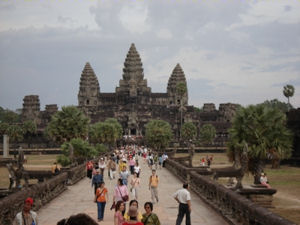 The Temples of Angkor are truly spectacular. Not only in terms of number and scale, but also in the intricacy of architecture.
The Temples of Angkor are truly spectacular. Not only in terms of number and scale, but also in the intricacy of architecture.
I had hired a bicycle to get around, but with the temperatures close to 40 degrees and the humidity well above 80% I sweated a lot over the next few days. I think it is fair to say out of the thousands of people also visiting the temples I only saw about 10 other cyclists, and half of those were the crazy Danish guys I had met in Vang Vieng. However, I love cycling and the freedom to do as you wish was great. Again, being hot season the place, while busy, was not as bad as at other times of year, and in the early morning, late evening and over lunchtimes you could almost have the less famous temple complexes to yourself. Cycling up the entrance road and getting the first glimpses of Angkor Wat was really special and filled me with excitement. Whilst you are sharing the experience with uncountable numbers of other people the temples are just left as they were, without signs or walk ways, and so it does feel a bit like you are exploring which makes it all the more fun.
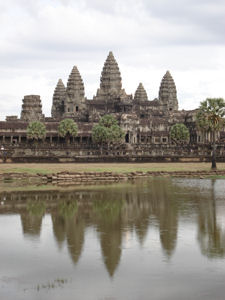
Angkor Wat was my first stop. An outer building surrounds the main structure and all of this is set in gardens that are also surrounded by yet more large walls. The Angkor architects liked to make their buildings tall, which leads to incredibly steep steps. Climbing up was alright, but after hundreds of years and millions of people, the steps are very rounded and, with no hand holds, getting back down was one of the more challenging things I did on my whole holiday.
It is impossible to describe everything here, there are so many buildings all with many rooms and all of these have exquisite sculptures or entire walls covered with carved scenes of stories or historic records. You think you've explored the whole place only to find another corridor with more inscriptions, and this is only the first of many temples - although it is one of the most elaborate. I could have spent hours here but really wanted to see as much as possible and with a 3-day limit on the visit I tried to keep a good pace, and did come back another evening to spend a bit more time looking at the better preserved areas.
My next stop was The Bayon. After Angkor Wat this is the second most famous structure. Whilst smaller in size, the whole building is covered in sculpted faces, each turret has one on each side, and there are many turrets. All the faces are the same and it is said that this face is that of the ruler at the time so he could always be looking everywhere. The corridors inside the Bayon are small and dark, with many twists and turns, and returning here in the evening was quite eerie although a really great experience.
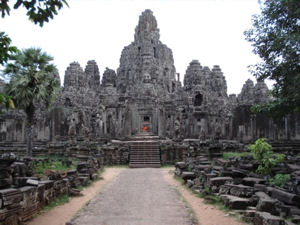 The Bayon is situated at the centre of a compound about 2 square miles in size. Most of this is full of trees but several other major buildings are also there. Near the Bayon is the Grand Palace, this building was carefully dismantled by French archaeologists who were analysing the site in the early twentieth century, unfortunately during the years of the khmer Rouge all records of how it was constructed were destroyed. Hence, now the area is likened to the ultimate jigsaw puzzle with hundreds of numbered stones lying in piles. Just beyond this is the Terrace of Elephants (picture). This is a 5-meter-high wall that runs for about a mile. To say the wall is sculpted is an understatement, the picture shows one of the better sections but all along its length the level of detail is similar, and often there are extra statues and the wall divides into rooms with all faces of equal intricacy. I cannot over state how impressive this area is. Having seen a number of temples and old cities around the world this really is on a different level.
The Bayon is situated at the centre of a compound about 2 square miles in size. Most of this is full of trees but several other major buildings are also there. Near the Bayon is the Grand Palace, this building was carefully dismantled by French archaeologists who were analysing the site in the early twentieth century, unfortunately during the years of the khmer Rouge all records of how it was constructed were destroyed. Hence, now the area is likened to the ultimate jigsaw puzzle with hundreds of numbered stones lying in piles. Just beyond this is the Terrace of Elephants (picture). This is a 5-meter-high wall that runs for about a mile. To say the wall is sculpted is an understatement, the picture shows one of the better sections but all along its length the level of detail is similar, and often there are extra statues and the wall divides into rooms with all faces of equal intricacy. I cannot over state how impressive this area is. Having seen a number of temples and old cities around the world this really is on a different level.
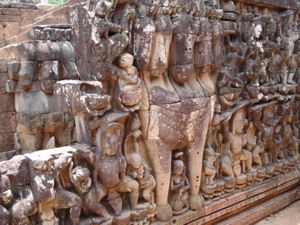 Following on from The Bayon area there are many more temples, one of my favourites being Preah Khan. This is slightly more run down and a little way from the main tourist centre so was quieter, but had lots of passages, tumbled down buildings and interesting courtyards to explore (picture of a guardian statue outside the temple entrance).
Following on from The Bayon area there are many more temples, one of my favourites being Preah Khan. This is slightly more run down and a little way from the main tourist centre so was quieter, but had lots of passages, tumbled down buildings and interesting courtyards to explore (picture of a guardian statue outside the temple entrance).
Angkor Wat is one of the major money makers in Cambodia - a country still recovering from total destruction and mass killings of Pol Pot and the khmer Rouge - and everywhere people are trying to sell stuff. However, the Cambodian people are really nice and are also smart about their techniques. No sellers are allowed in the actual temple areas and this is actually abided by, so you're not constantly hassled, and bargaining for things like water can often be skipped - I quickly found that if I just gave the right money (about third of the asking price) no-one complained and speeded up proceedings somewhat. Young children are sent out to sell the souvenirs - it's harder to say no to sweet looking kids - but they too are cleaver. After asking which country you are from they would reel off a list of the capital city, prime minister and for England usually say 'lovely jubbly' or a similar catch phrase to finish before trying to look needy and push their wares at you.
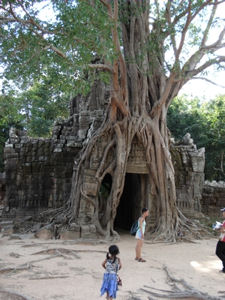 The little girl in the photo was a bit confused over the nationality of the people so was counting to 10 in English followed by French, German, Japanese, Chinese, Thai and a few other languages - they know their stuff. I bought postcard from a little boy who, when told I already knew the capital of England said he bet I didn't know the capitol of Sri Lanka. I feel I should have known this but could not remember so was happy to buy his cards in return for him telling me. The children also have good memories. The first morning of my first day I parked my bike and a little girl said she would look after it if I bought a scarf. I did not commit as I did not really need a scarf but indicated I might as I did not want to just say no. Three days later on my last evening I again parked my bike and the same girl ran over saying that three days ago I said I might buy a scarf and now I should - she must have talked to hundreds of foreigners in that time but still remembered me (having said that there might not have been many other blond-haired guys on push bikes), again I felt for this level of effort it deserved something so did buy a scarf. My best bargain all trip was from a group of school kids hanging around in one of the temples. I had been planning on buying a guide book with nice colour photos and seen one I quite liked, but it was usually quite expensive. I'm not sure where these kids had got the books from - off the back of a lorry perhaps - but as I used the usual uninterested technique the price fell more than usual and I started to get interested.
The little girl in the photo was a bit confused over the nationality of the people so was counting to 10 in English followed by French, German, Japanese, Chinese, Thai and a few other languages - they know their stuff. I bought postcard from a little boy who, when told I already knew the capital of England said he bet I didn't know the capitol of Sri Lanka. I feel I should have known this but could not remember so was happy to buy his cards in return for him telling me. The children also have good memories. The first morning of my first day I parked my bike and a little girl said she would look after it if I bought a scarf. I did not commit as I did not really need a scarf but indicated I might as I did not want to just say no. Three days later on my last evening I again parked my bike and the same girl ran over saying that three days ago I said I might buy a scarf and now I should - she must have talked to hundreds of foreigners in that time but still remembered me (having said that there might not have been many other blond-haired guys on push bikes), again I felt for this level of effort it deserved something so did buy a scarf. My best bargain all trip was from a group of school kids hanging around in one of the temples. I had been planning on buying a guide book with nice colour photos and seen one I quite liked, but it was usually quite expensive. I'm not sure where these kids had got the books from - off the back of a lorry perhaps - but as I used the usual uninterested technique the price fell more than usual and I started to get interested.
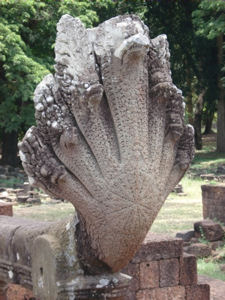
It was late in the day so I would probably be the last sale and after about 10 minutes of discussion we came to an agreement that I could have the book for a few dollars which seemed like a great bargain to me. I paid half in US Dollars and half in Thai Bart and got the change in Cambodian Riel. When I ask why they were keen to have Thai money they said they could make extra money with the exchange rate so we all left happy.
On my second day I cycled out to a much older, and less grand, set of temples known as the Roluos Group. These were about 10 Km from Siem Reap on a road had little shade, making it hard going. It was very quiet here and as I was wandering around I met a local man who was working on the restoration of one of the towers. I think he was quite bored and wanted to practice his English as he took me to the top of the scaffolding and showed me all the tools and practices they use for the restoration. I hadn't realised that any stones that are badly damaged are removed and replaced with new ones. This means that quite a lot of the temples are technically new, although the techniques and materials used are the same as in ancient times so they still look authentic and it stops the temples falling down so I guess is the best compromise. He also told me that the restoration projects used to be backed by the Japanese and Germans, but recently the money had dried up and now only the Cambodian government was funding the project - meaning he had to work in a restaurant at night to pay the bills. He wanted an English dictionary and after hearing this I would have been only too pleased to provide one, however I had nothing useful on my person so sadly could not.

I had planned to explore a temple on the map another 6 miles up a dirt track and asked about what I would find. He told me it was a temple that was still to be restored and was surrounded by jungle - what Lonely Planet also said and just the sort of place I wanted to see. Unfortunately, after cycling a few miles around the sandy tracks at the Roluos Group I had picked up a slow puncture. There are many little houses along the main road which sell petrol and drinks etc, and thinking it wasn't too bad I got the tyre pumped up and continued. This was OK for another mile until the flat got worse and I had to push my bike for a few miles in the midday sun to find someone to fix it. I found an old man asleep at the roadside who had a small repair kit and a few other bits and pieces, after some general hand signals, he fixed the puncture and I was on my way. After all this extra effort and sun I didn't think I could cope with 5 miles of sandy tracks so turned around and cycled back to the main temple area, stopping several times at roadside stands for a cold drinks made from crushed sugar cane and ice – a local specialty and the perfect refresher. Getting back in time to still see a little more I spent the late afternoon revisiting some of my favourite temples from the previous day.
 On my final day I wanted to explore some of the other more out of the way places, and having cycled more than 30 miles each of the previous days (the temples are quite a long way apart) I planned to take it a bit easy. Taking it easy is something I'm not always very good at and after climbing a hill for a view over the main temple area I went to explore the reservoir. Cycling down little tracks was good fun and when it tuned into sandy heath, I thought I must be nearly there. However, a large part of the reservoir had dried up and with no defining perimeter I had managed to cycle right into it. I only discovered this after another hour of hard cycling over sandy ground, again in the midday sun, and there was nothing much to see when I finally got to the water's edge. As I cycled, I saw a few groups of kids herding cattle or picking berries. This pleased me as Cambodia has more landmines than almost any other country in the world, and it is advised not to leave the path - I had figured that I was safe as cattle were scattered around and they would likely not have been if land mines where still present, but the sight of the children was also quite reassuring. In the afternoon I worked my way around more of the temple complexes outside the main area and that evening I treated myself to a cold beer in the famed Angkor What? Bar.
On my final day I wanted to explore some of the other more out of the way places, and having cycled more than 30 miles each of the previous days (the temples are quite a long way apart) I planned to take it a bit easy. Taking it easy is something I'm not always very good at and after climbing a hill for a view over the main temple area I went to explore the reservoir. Cycling down little tracks was good fun and when it tuned into sandy heath, I thought I must be nearly there. However, a large part of the reservoir had dried up and with no defining perimeter I had managed to cycle right into it. I only discovered this after another hour of hard cycling over sandy ground, again in the midday sun, and there was nothing much to see when I finally got to the water's edge. As I cycled, I saw a few groups of kids herding cattle or picking berries. This pleased me as Cambodia has more landmines than almost any other country in the world, and it is advised not to leave the path - I had figured that I was safe as cattle were scattered around and they would likely not have been if land mines where still present, but the sight of the children was also quite reassuring. In the afternoon I worked my way around more of the temple complexes outside the main area and that evening I treated myself to a cold beer in the famed Angkor What? Bar.
My next destination was Malaysia and rather than take the two-to-three-day overland route, for a similar price I could fly with Air Asia, the Malaysian equivalent of Ryan Air. Since my credit card still wasn't working - I had forgotten to activate it and could also not remember my pin number - my mum booking the flight for me; she was also a star and sorted out the whole credit card mess so within 3 weeks I had two working cards, making life a lot easier.